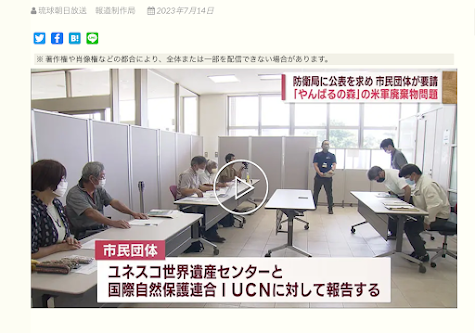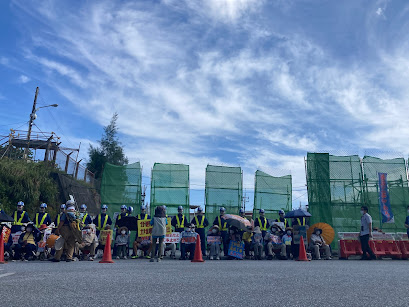Report on Meeting with Okinawa Defense Bureau over World Heritage Yambaru Forest
On July 14, five members of Okinawa's civil society met with officials of the Okinawa Defense Bureau over the issues of the U.S. military's discarded materials in the UNESCO World Natural Heritage Yambaru forest. The members were Akira Shimizu and Ikuko Isa of the No Helipad Takae, Noboru Gibo and Koichi Miyahira of the Okima River Basin Protection Found, and myself, Hideki Yoshikawa, of the OEJP. (We express our appreciation to Akino Miyagi, butterfly researcher who has made the issues of discarded military materials in the World Heritage site widely known.)
 |
| QAB reports our meeting Image Source: QAB Ryukyu Asahi Broadcasting Co. |
The meeting was part of the Civil Society's ongoing efforts to make the Yambaru forest a genuine World Heritage site: a World Heritage site without dangerous discarded military materials, impactful military training, and eventually, without the U.S. military's Northern Training Area that at present sits next to it. Intending to incorporate the Bureau's responses to our report to the UNESCO World Heritage Centre and the International Union for Conservation of Nature (IUCN), we engaged in a 30 minute-exchange with the Bureau based on our questions and requests submitted two weeks before the meeting.
The meeting went as expected: we got confirmation on the obvious facts and confusing responses in official rhetoric to our requests. For us, like many other meetings between the Bureau and civil society members, it was like a farce, superficial and frustrating because it appeared to be going nowhere. Still, it was a kind of farce that civil society members must participate in to get rid of the farce-ness out of it and push things moving forward. The fact that the Yambaru forest is now a World Heritage site made our attempt much easier than before.
Summary of Our Exchange
Question:
What is the Bureau's take on the inscription of the Yambaru forest as a World Heritage site?
Answer:
The Okinawa Defense Bureau welcomes the inscription of the forest, along with Amami Oshima, Tokunoshima, and Iriomote Island, as a World Heritage site. The Bureau makes efforts, in collaboration with related organizations, to conserve the environment of the forest.
Question:
What are the Bureau's responsibilities regarding the U.S. military's discarded materials in the UNESCO World Heritage site? What laws oversee the Bureau's fulfillment of its responsibilities?
Answer:
The Okinawa Defense Bureau is responsible for cleaning up the U.S. military's discarded materials in the World Heritage site.
Before the return of former NTA lands to Japan and the incorporation of them into the then World Heritage nomination site, the Bureau conducted an initial clean-up in those lands in accordance with the laws, Act on Special Measures Incidental to Reversion of Lands in Okinawa Prefecture Offered for Use by United States Forces in Japan(跡地利用特措法) and Soil Contamination Countermeasures Act (土壌汚染対策法).
Since the return of the lands and their incorporation into the then World Heritage nomination site, the Bureau has been carrying out clean-ups in the present UNESCO site under the Soil Contamination Countermeasures Act.
The Bureau has issued reports on its clean-up efforts. The report on the initial clean-up is publicly accessible on its website. However, the reports on its clean-up efforts conducted after the return of the lands have not been made public.
Question:
How long will the Bureau plan to continue its clean-up efforts?
Answer:
The Bureau will carry out cleaning up as new discarded military materials are found.
Question:
Who should people contact when they find a U.S. military's discarded materials in the UNESCO site?
Answer:
They should contact the Bureau.
Request:
Please make accessible on its website all the Bureau's reports on its clean-up efforts of the military materials in the forest.
Response:
In consultation with related organizations, the Bureau will take proper action.
Request:
Please put sign-boards up in and around the World Heritage Yambaru forest informing that the U.S. military's discarded materials are still in the UNESCO site and caution is required, and that, if people find such material, they should contact the Bureau.
Response:
In consultation with related organizations, the Bureau will take proper action.
Clarification on the Officials' Rhetoric
After the meeting, I called the Bureau, trying to get clarification on the answers provided at the meeting, and a public relation official took my call. I told him that their official rhetoric, "we will take proper action," was confusing because it could be interpreted in many ways. I told him that, for us to report what was discussed at the meeting to UNESCO and IUCN, I needed plain answers in the internationally plain language. I asked him whether I should report to UNESCO and IUCN, but the Bureau gave no definite answers. He told me he needed to consult with others and asked me to wait for a while.
When he returned to the phone, he told me that the Bureau stands by the wording that it will "take proper action." Then, I went nitpicking, asking whether the words "take proper action" include "not making the reports public" and whether I should report to UNESCO and IUCN that possibility as well. Then, he quickly responded by saying that it was not that the Bureau would not make the reports publicly accessible; the Bureau would need to discuss the timing of making the reports accessible and other related matters. So apparently, the Bureau is to release the reports sometime soon.
Concluding Notes
It is ridiculous that the Okinawa Defense Bureau has not made its clean-up reports publicly available, and the civil society has to ask the Bureau to do so. As I insisted at the meeting, the Bureau has been doing a commendable job, fulfilling its responsibilities required by domestic laws for the UNESCO World Heritage site. It should have proudly publicized its clean-up efforts.
At the same time, the Bureau is just following the Ministry of the Environment and the Ministry of Defense, which have disappointed Okinawa Civil Society with their reluctance to discuss any negative aspects of the U.S. military in Okinawa. In its World Heritage nomination dossier, the Ministry of the Environment mentioned the presence of the Northern Training Area (NTA) only in passing. It did not discuss any negative aspects of the NTA for the Yambaru forest. Only after civil society brought the issues of the NTA to UNESCO and IUCN did the Ministry of the Environment begin discussing them in the nomination process. Also, the Ministry of the Environment has refused NGOs' request that the ministry include a summary of the Okinawa Defense Bureau's reports on the clean-up efforts in the ministry's reports to UNESCO and IUCN.
The Ministry's refusal to be forthcoming with U.S. military-related issues undermines the Outstanding Universal Value (OUV) of the Yambaru forest and the integrity of the World Heritage Convention. The Okinawa Defense Bureau's reluctance to make the reports publicly accessible also undermines the OUV of the forest and the integrity of the World Heritage Convention. Okinawa's civil society, along with UNESCO and IUCN, has the responsibility to make the Japanese government accountable.
To conclude this report, I quote Ikuko Isa's memorable comments made at the meeting. They capture the truth of the World Heritage Yambaru forest and point to the challenge we, the civil society, UNESCO, IUCN, and the Japanese and U.S. governments, all face.
"As the lands that existed as the U.S. military's training lands behind the fence were returned to Japan, the Yambaru forest became a World Heritage site. We were happy and expected that we could now visit and enjoy the returned lands. But now we have the U.S. military's discarded materials found in them. Now the ropes are set up, circling the areas (where discarded materials were found), and we cannot enter. How should we take this situation? Can we still call it a World Heritage site?"
We have a long way to go before we can make the Yambaru forest a genuine World Heritage site, for sure. But we believe it is a journey worth taking.


